Walking pain doesn’t have to be inevitable as you age. A surprising 5-7 minute routine targeting ankle mobility and hip flexibility can transform your daily walks from uncomfortable to enjoyable—but the timing of when you stretch matters more than you think.
Key Takeaways
- Seven specific stretches performed before walking can significantly reduce pain and stiffness for seniors aged 65+
- Movement-based stretching is safer and more effective than static holds before walking
- Chair-assisted modifications allow seniors with limited mobility to safely prepare for walking
- Proper ankle mobility is crucial for preventing trips and falls during walking
- A 5-7 minute pre-walk routine can dramatically improve walking performance and reduce injury risk
Walking remains one of the most accessible forms of exercise for older adults, but age-related muscle stiffness and joint restrictions can turn this simple activity into a source of discomfort or injury. The good news? A targeted stretching routine performed before walking can transform the experience from painful to pleasurable.
Why These 7 Stretches Prevent Walking Pain for Seniors
As we age, natural changes in tissue elasticity and decreased activity levels lead to stiffer muscles and joints. Walking involves all major muscle groups in the lower body – calves, hamstrings, quadriceps, hip flexors, and glutes. When these muscles aren’t properly prepared, microscopic tears can occur, leading to inflammation and pain that can persist long after the walk ends.
Medical professionals recommend warming up muscles with light activity for 5-10 minutes before stretching to increase blood flow and prepare them for movement, significantly reducing the risk of injury. This preparation becomes even more critical for seniors, as their muscles are naturally less flexible and take longer to warm up.
The strategic selection of these seven exercises addresses the most common problem areas that cause walking discomfort. By targeting ankle mobility, calf flexibility, and hip function, this routine tackles the root causes of pain before they can develop. Expert resources on senior fitness consistently emphasize that prevention through proper preparation is far more effective than treating pain after it occurs.
The Essential Pre-Walk Stretches That Matter Most
These seven exercises form a complete routine that addresses the key muscle groups needed for safe, comfortable walking. Each movement serves a specific purpose in preparing the body for the repetitive motion and balance challenges that walking presents.
1. Ankle Circles – Your Foundation for Stable Steps
Ankle circles improve mobility and circulation in the ankles, which is crucial for efficient push-off and landing during walking. Many seniors neglect ankle mobility, yet this joint serves as the first point of contact with the ground and directly impacts balance and stability.
How to perform: Stand tall holding a chair or wall for support. Lift one foot slightly off the ground and make slow, controlled circles with your ankle – 10 clockwise, then 10 counterclockwise. Keep the movement smooth and deliberate. The ankle should do all the work while the knee remains relatively still. Repeat with the other foot.
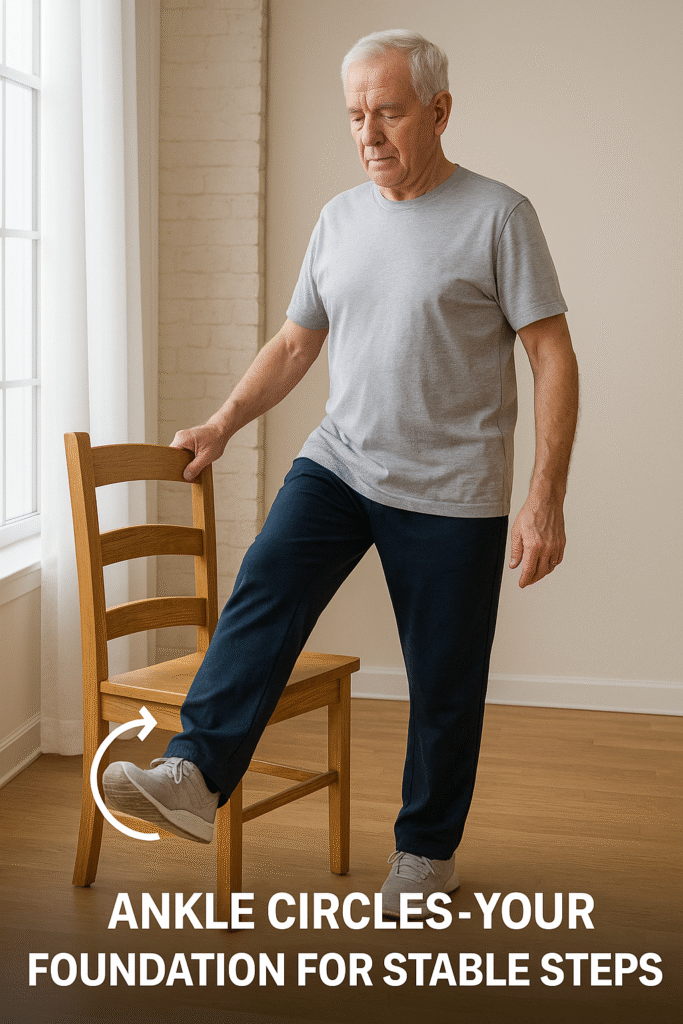
2. Wall-Supported Calf Stretch – Improve Ankle Flexibility
Tight calf muscles can lead to injuries like Achilles tendon strain and contribute to the shuffling gait pattern common in older adults. This stretch reduces stiffness in the posterior lower leg while improving the ankle flexibility needed for proper ground clearance.
How to perform: Stand facing a wall with arms extended against it. Step your left foot back about 2-3 feet, keeping your left heel firmly on the ground. Lean forward into the wall, feeling the stretch in your left calf. Hold for 15-30 seconds, then repeat with the right leg.
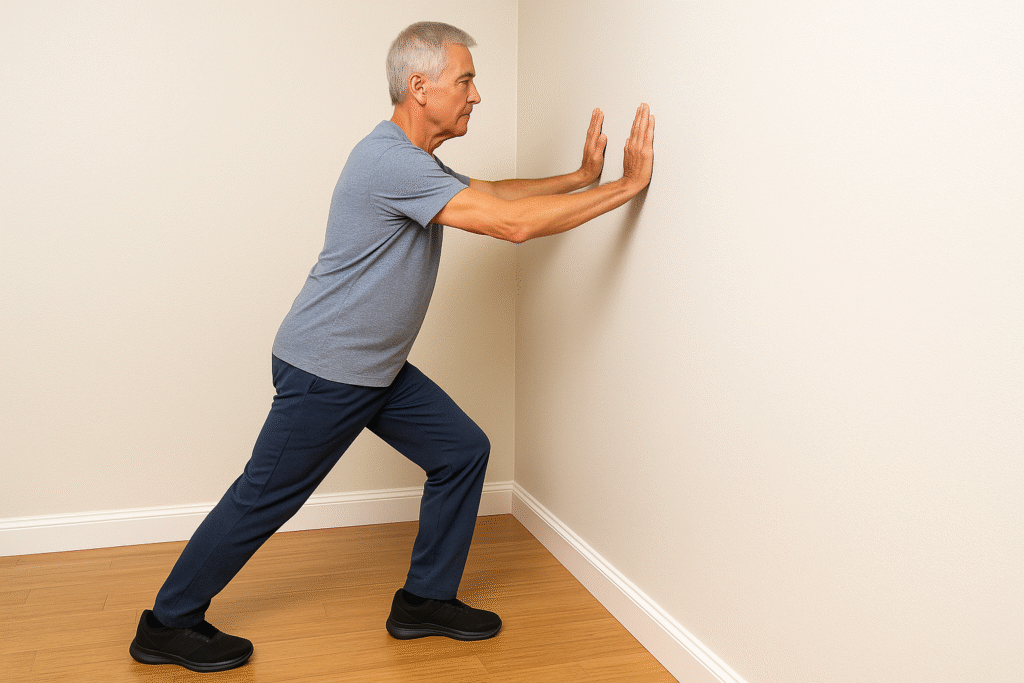
3. Standing Quadriceps Stretch – Keep Knees Strong
Quadriceps stretches prevent chronically tight thigh muscles, which are needed for keeping knees straight during walking. The quadriceps are the largest muscle group in the legs and contract to maintain knee stability throughout the walking cycle.
How to perform: Stand next to a chair or wall for support. Bend your right knee, bringing your foot toward your buttocks. Gently grasp your ankle with your right hand, keeping your knees close together and maintaining upright posture. Feel the stretch along the front of your thigh, hold for 15-30 seconds, then repeat with the left leg.
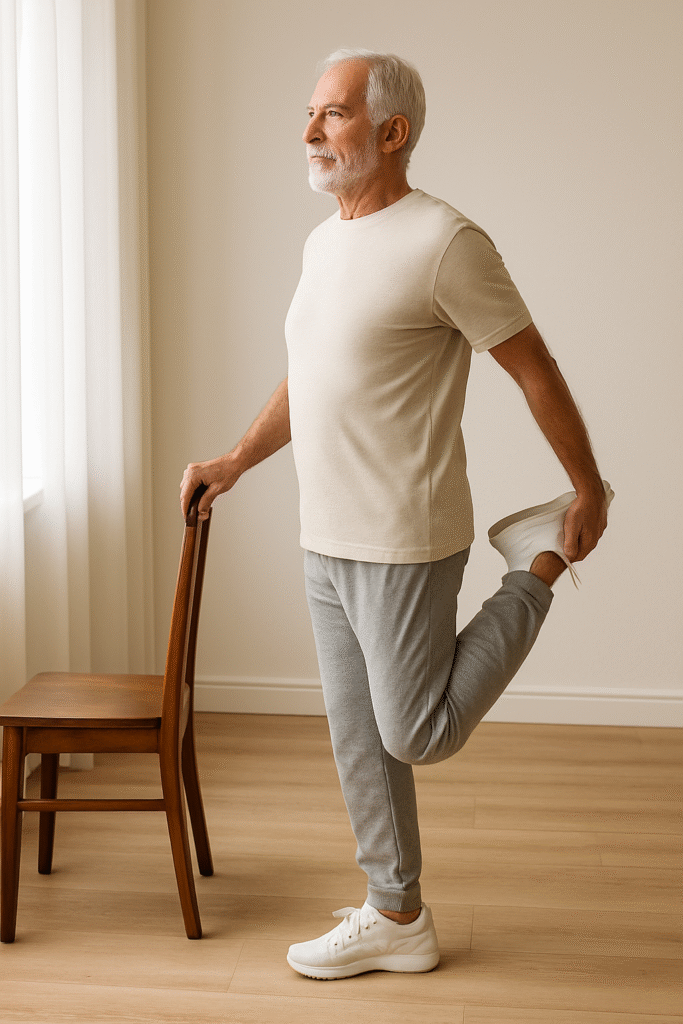
4. Seated Hamstring Stretch – Support Healthy Circulation
Hamstring stretches, especially seated versions, improve pelvic mobility and can alleviate lower back pain by improving walking posture. This seated approach is safer for seniors with balance concerns while still providing effective muscle preparation.
How to perform: Sit on the edge of a sturdy chair and extend your right leg straight out with heel on floor. Keep your right foot flexed with toes pointing up. Slowly lean forward from your hips, reaching toward your ankle until you feel a gentle stretch behind your thigh. Hold for 15-30 seconds, then repeat with the left leg.
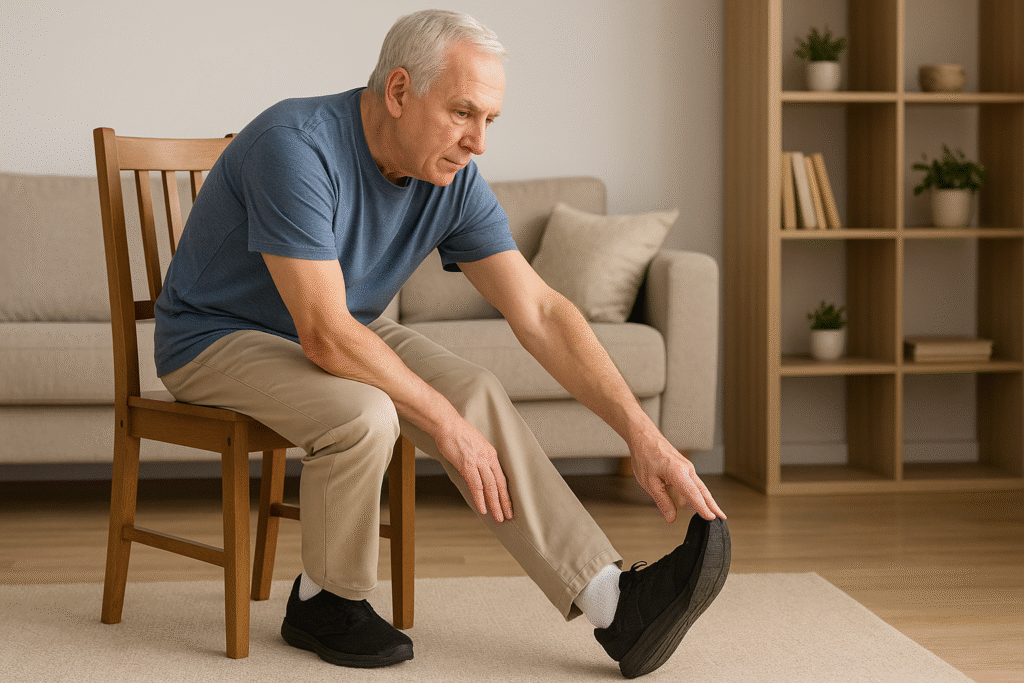
5. Hip Flexor Stretch – Counter Stiffness from Sitting
Hip flexor stretches are important because these muscles often become tight from prolonged sitting, leading to poor posture and walking difficulties. Tight hip flexors can limit stride length and force the lower back to compensate, creating a cascade of movement problems.
How to perform: Stand with feet hip-width apart. Step your left foot back into a lunge position, keeping your right knee over your right ankle. Gently push your hips forward while keeping your torso upright. Feel the stretch in the front of your left hip, hold for 15-30 seconds, then repeat with the right leg back.
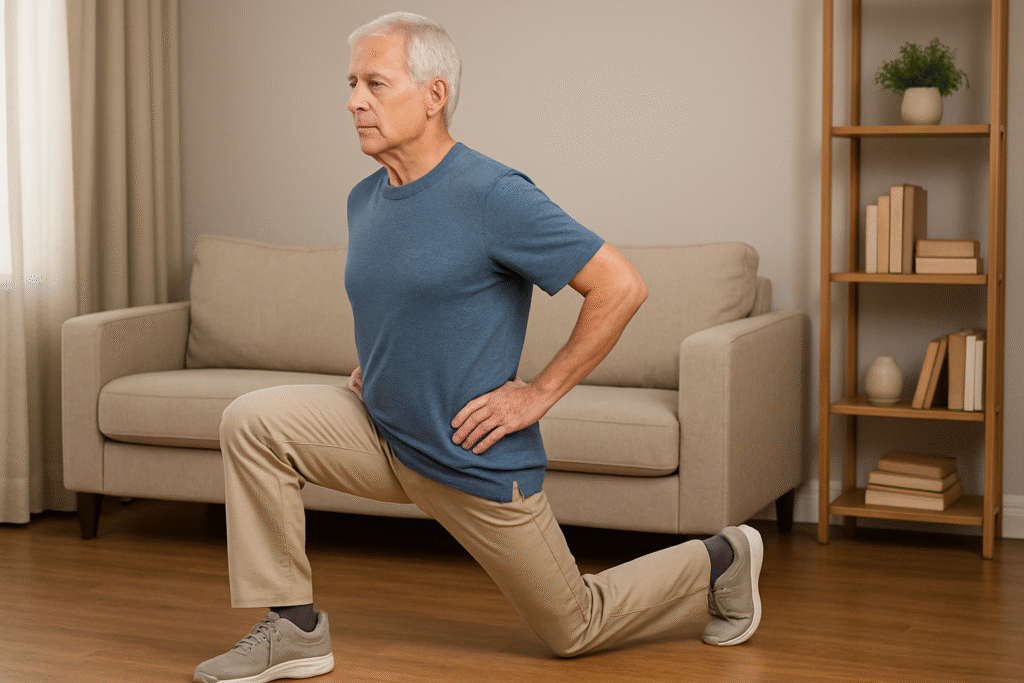
6. Leg Swings – Engage Hip and Thigh Muscles
Leg swings help activate walking muscles while improving range of motion. This movement prepares the neuromuscular system for the walking motion ahead by rehearsing the pendulum-like motion of the legs during gait.
How to perform: Stand beside a chair or wall for support, holding with your left hand. Swing your right leg forward and back like a pendulum, keeping the movement controlled and within a comfortable range. Perform 10-15 forward/back swings, then swing your right leg side to side 10-15 times. Repeat with your left leg.
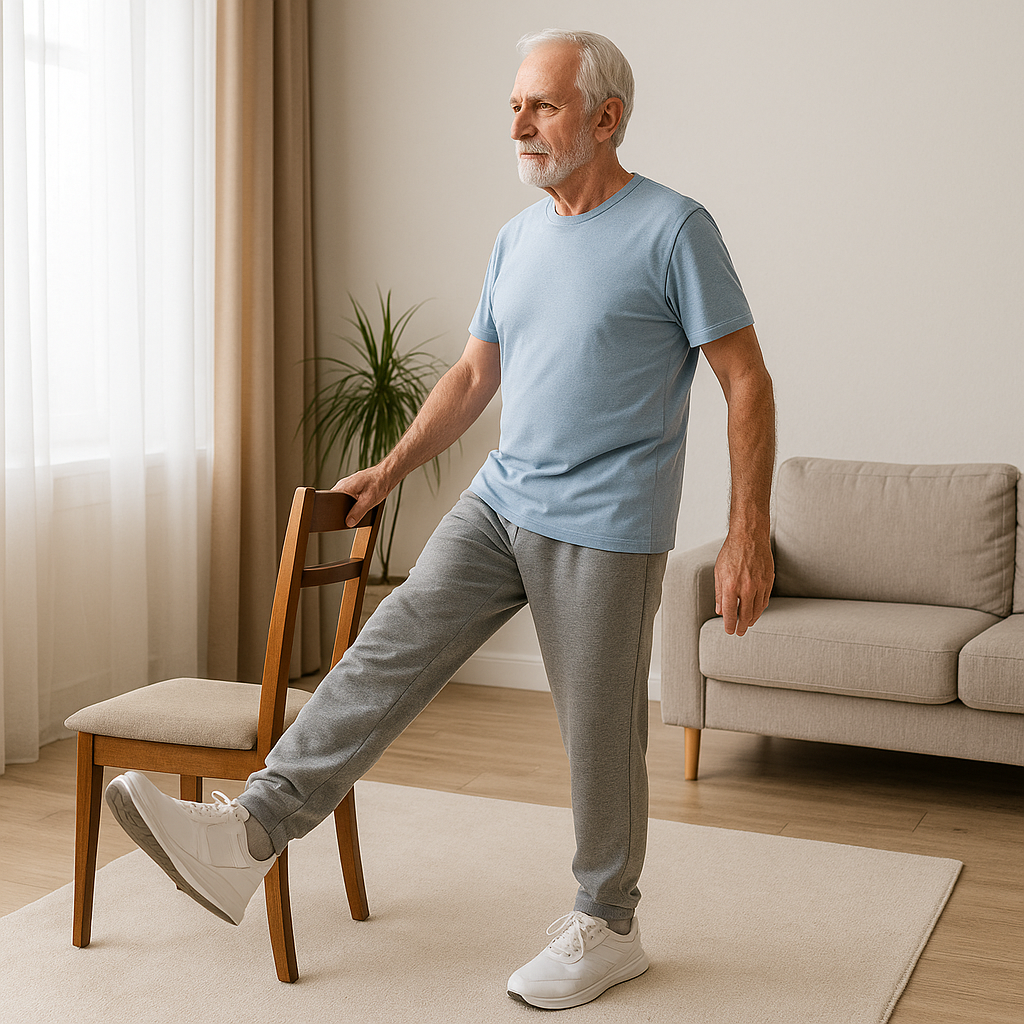
7. Knee to Chest – Improve Hip Mobility
This stretch improves hip and knee flexibility while gently mobilizing the lower back. It’s particularly beneficial for seniors who spend considerable time sitting, as it counters the hip flexor tightness and lower back stiffness that develops from prolonged sitting.
How to perform: Stand with feet hip-width apart, holding a chair for support. Lift your right knee toward your chest, wrap your hands around your knee and gently pull. Hold for 4 seconds while maintaining good posture. Lower your leg and repeat with the left. Continue alternating for 8-10 repetitions per leg.
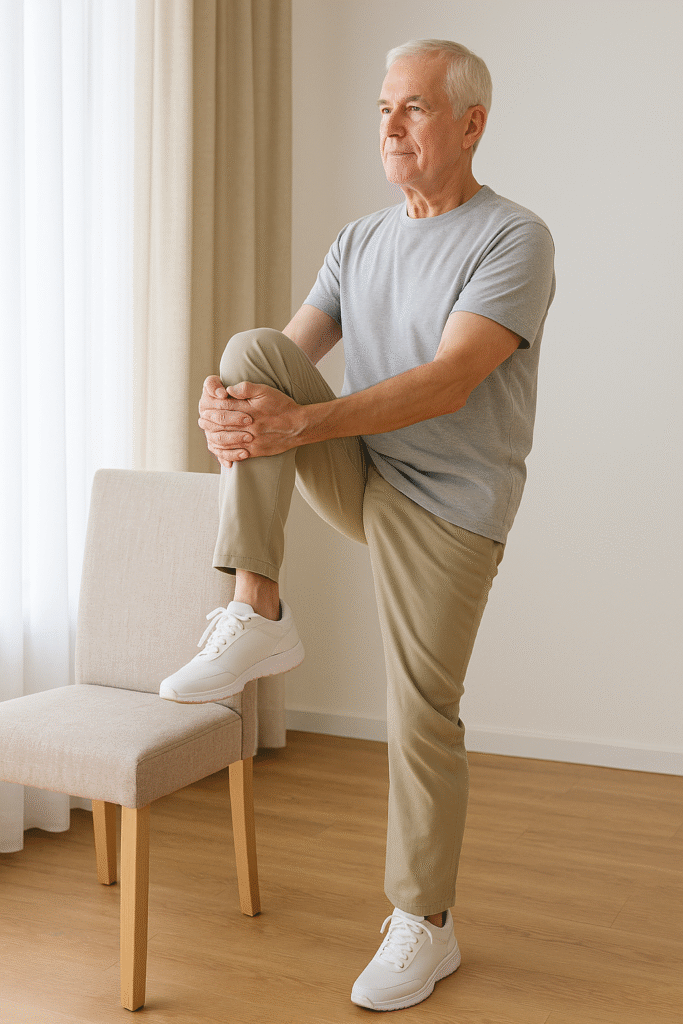
Movement-Based vs Static Stretching: Understanding the Difference
The type of stretching performed before walking significantly impacts both safety and effectiveness. Movement-based stretching, involving controlled movements, is generally recommended before walking to improve blood flow and muscle temperature. Static stretching can be beneficial when held for shorter durations (15-30 seconds), but extended static holds are better reserved for after physical activity.
How Movement-Based Exercises Mimic Walking Motion
Movement-based stretching involves continuous, controlled movements that prepare the body by simulating the motions required during walking. Movements like leg swings and ankle circles activate neuromuscular pathways, elevate internal muscle temperature, and encourage joints to move actively through their necessary range of motion. This preparation enables coordinated, rapid responsiveness needed during walking.
For seniors, movement-based exercises provide functional rehearsal of walking patterns while building confidence in movement. The controlled nature of these exercises allows older adults to practice balance and coordination in a safe, supported environment before transitioning to actual walking.
When Static Holds Benefit Seniors Most
Static stretching involves holding a position at the end range of motion for 15-30 seconds. While highly effective for improving overall flexibility over time, static stretching can temporarily decrease muscle force output when held for extended periods immediately before activity. For seniors, this reduction in immediate muscle power can lead to slower stabilizing reactions when stumbling.
However, brief static stretching (15-30 seconds maximum) can improve flexibility and ankle dorsiflexion, which may help prevent trips. The key is using brief, controlled static holds for specific tight areas, followed by movement-based activation exercises.
Chair-Assisted Modifications for Limited Mobility
For seniors with limited mobility, balance issues, or those using mobility aids, chair-assisted stretches provide a safe and effective way to improve flexibility and prepare for walking. These modifications ensure that physical limitations don’t prevent proper pre-walk preparation.
Seated Versions of Key Stretches
Most of the needed pre-walk stretches can be adapted for seated performance. Seated ankle circles can be performed by sitting tall in a chair with feet flat on floor, then lifting one foot slightly to perform circles – providing more stability than the standing version. The seated calf stretch involves sitting forward in a chair, extending one leg straight with heel on floor, flexing the foot and leaning forward gently.
For hip flexibility, the seated figure-four position works effectively: sit tall and place one ankle over the opposite knee, then gently lean forward while maintaining a straight back. This targets tight hips and can alleviate associated lower back pain that often accompanies walking difficulties.
Using Support for Standing Exercises
When standing exercises are possible with support, using a chair back for balance throughout the stretch ensures safety. The range of motion can be modified as needed, and maintaining one hand on the chair throughout the movement provides stability. Chair-supported standing exercises allow seniors to progress from seated versions as their balance and confidence improve.
Upper body warm-up exercises like neck circles, shoulder rolls, and arm circles can be performed while seated, preparing the entire body for movement and ensuring the natural arm swing necessary for balanced walking.
Critical Safety Guidelines for Senior Stretching
Safety must be the primary consideration when seniors perform pre-walk stretches. Following established guidelines ensures that stretching improves rather than compromises walking safety and comfort.
Start Slowly and Progress Gradually
Always begin with 5-10 minutes of gentle movement like marching in place before stretching to warm muscles and increase blood flow. This preparation prevents the micro-tears that can occur when cold muscles are suddenly elongated. Regular stretching improves joint mobility, particularly in the ankles, knees, hips, and spine, but improvements develop gradually over time.
Individual adaptation is needed, as stretching responses vary significantly between people. Programs may need customization based on specific needs, limitations, and health conditions. Starting with shorter hold times and smaller ranges of motion allows the body to adapt safely.
Proper Breathing and Pain Awareness
Maintain rhythmic, deep breathing throughout every movement – never hold your breath during stretches. Proper breathing ensures steady oxygen flow and promotes relaxation during stretching. Stretch only to the point of mild tension or a gentle pull, never to the point of pain.
Pain signals over-stretching, which can lead to tissue damage. The correct sensation should register as mild discomfort rather than sharp or intense pain. If pain occurs, immediately reduce the intensity or stop the stretch entirely.
Avoid Bouncing and Jerky Movements
All movements must be slow, gentle, and controlled. Bouncing or jerky movements dramatically increase the risk of muscle strain or injury, particularly in older adults whose tissues are less resilient. The goal is smooth, deliberate motion that respects the body’s current limitations while gradually improving flexibility.
Utilize sturdy support like a chair, counter, or wall for balance during all standing exercises. This external support acts as a critical safety measure against potential falls and allows seniors to focus on proper stretch technique rather than balance concerns.
Start These Stretches Today to Walk Pain-Free Tomorrow
Implementing this seven-exercise routine requires just 5-7 minutes but can transform the walking experience for seniors. The beauty of this protocol lies in its adaptability – whether you’re a mobile senior looking to improve walking performance or someone with limited mobility using chair-assisted modifications, these exercises can help maintain an active, healthy lifestyle.
Consistency proves more important than perfection. Performing these stretches at least 2-3 times per week, ideally before each walk, provides cumulative benefits that build over time. Even a few minutes of pre-walk stretching can significantly reduce the risk of pain and injury while improving the overall walking experience.
The strategic focus on ankle mobility, hip flexibility, and muscle activation addresses the most common sources of walking discomfort in older adults. By preparing these key areas before each walk, seniors can maintain their independence and continue enjoying one of the most beneficial forms of exercise available to them.
For guidance on senior fitness and mobility, visit Healthfit Publishing, where expert resources help older adults maintain active, healthy lifestyles through evidence-based wellness strategies.